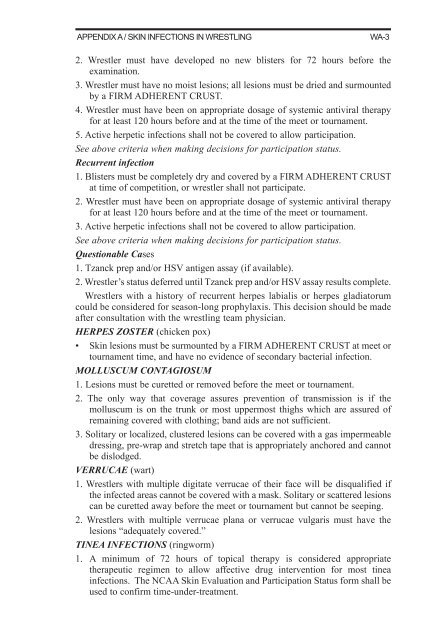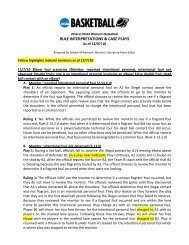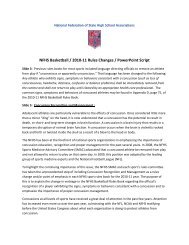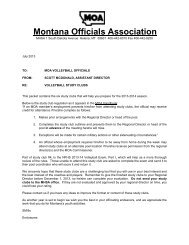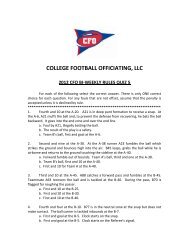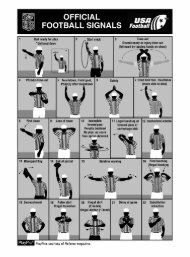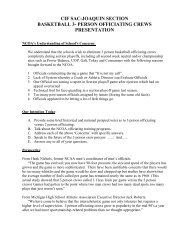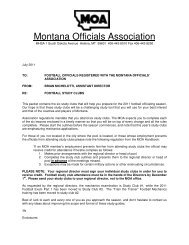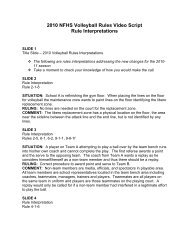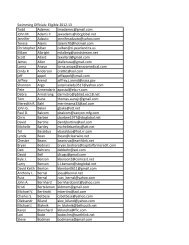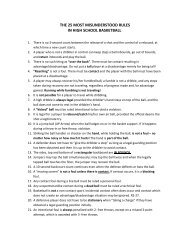(PDF). - NCAA Wrestling Officiating
(PDF). - NCAA Wrestling Officiating
(PDF). - NCAA Wrestling Officiating
You also want an ePaper? Increase the reach of your titles
YUMPU automatically turns print PDFs into web optimized ePapers that Google loves.
APPENDIX A / SKIN INFECTIONS IN WRESTLINGWA-3<br />
2. Wrestler must have developed no new blisters for 72 hours before the<br />
examination.<br />
3. Wrestler must have no moist lesions; all lesions must be dried and surmounted<br />
by a FIRM ADHERENT CRUST.<br />
4. Wrestler must have been on appropriate dosage of systemic antiviral therapy<br />
for at least 120 hours before and at the time of the meet or tournament.<br />
5. Active herpetic infections shall not be covered to allow participation.<br />
See above criteria when making decisions for participation status.<br />
Recurrent infection<br />
1. Blisters must be completely dry and covered by a FIRM ADHERENT CRUST<br />
at time of competition, or wrestler shall not participate.<br />
2. Wrestler must have been on appropriate dosage of systemic antiviral therapy<br />
for at least 120 hours before and at the time of the meet or tournament.<br />
3. Active herpetic infections shall not be covered to allow participation.<br />
See above criteria when making decisions for participation status.<br />
Questionable Cases<br />
1. Tzanck prep and/or HSV antigen assay (if available).<br />
2. Wrestler’s status deferred until Tzanck prep and/or HSV assay results complete.<br />
Wrestlers with a history of recurrent herpes labialis or herpes gladiatorum<br />
could be considered for season-long prophylaxis. This decision should be made<br />
after consultation with the wrestling team physician.<br />
HERPES ZOSTER (chicken pox)<br />
• Skin lesions must be surmounted by a FIRM ADHERENT CRUST at meet or<br />
tournament time, and have no evidence of secondary bacterial infection.<br />
MOLLUSCUM CONTAGIOSUM<br />
1. Lesions must be curetted or removed before the meet or tournament.<br />
2. The only way that coverage assures prevention of transmission is if the<br />
molluscum is on the trunk or most uppermost thighs which are assured of<br />
remaining covered with clothing; band aids are not sufficient.<br />
3. Solitary or localized, clustered lesions can be covered with a gas impermeable<br />
dressing, pre-wrap and stretch tape that is appropriately anchored and cannot<br />
be dislodged.<br />
VERRUCAE (wart)<br />
1. Wrestlers with multiple digitate verrucae of their face will be disqualified if<br />
the infected areas cannot be covered with a mask. Solitary or scattered lesions<br />
can be curetted away before the meet or tournament but cannot be seeping.<br />
2. Wrestlers with multiple verrucae plana or verrucae vulgaris must have the<br />
lesions “adequately covered.”<br />
TINEA INFECTIONS (ringworm)<br />
1. A minimum of 72 hours of topical therapy is considered appropriate<br />
therapeutic regimen to allow affective drug intervention for most tinea<br />
infections. The <strong>NCAA</strong> Skin Evaluation and Participation Status form shall be<br />
used to confirm time-under-treatment.


